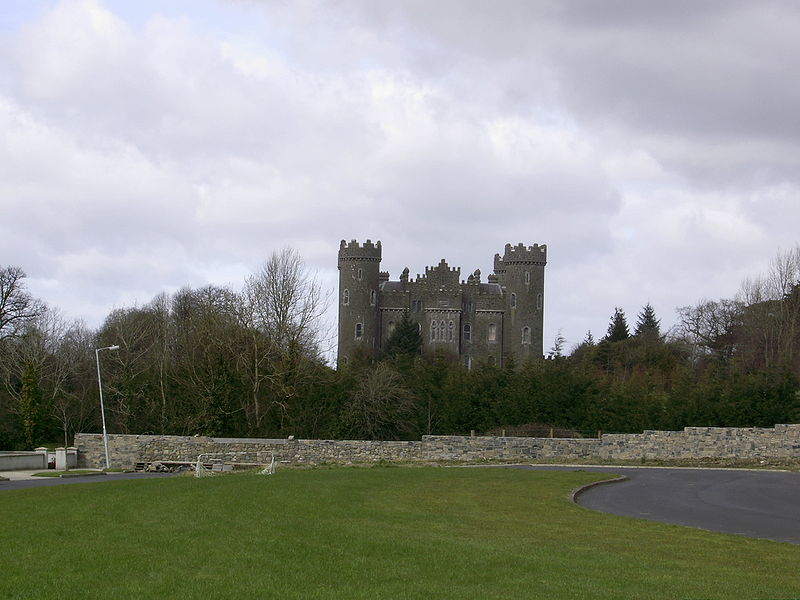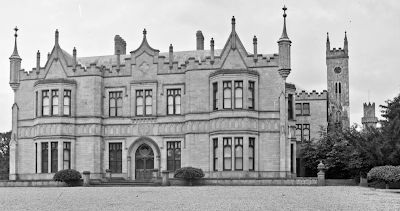THE RAMS OWNED 1,813 ACRES OF LAND IN COUNTY WEXFORD
In this country there were mines of silver, copper, and lead, belonging to the Hanoverian crown; the chief of these mines was Rammelsberg, a high mountain near the town of Goslar, in Hanover, twenty-five miles south of Wolfenbüttel.
The mines were discovered by one RAM, a hunter, whose horse's foot struck up a piece of ore in the year 972, from which circumstance Rammelsberg had its name; and the Emperor OTHO got a company of Franks from Frankenberg, who understood minerals, to refine the metal.
A branch of the family were residents of the city of Utrecht in the 15th century; and probably, at a much earlier period, one of them, François, Baron de Ram van Hagedoorn, colonel of an infantry regiment, died there in 1701, leaving two daughters.
THE place whence the English branch of this family derive latterly is Halstow, in Kent.
SIR JOHN RAM, Knight, of Halstow, Kent, living in 1442, was father of
THOMAS RAM, living in 1472, who was father of
WILLIAM RAM, living in 1503, who had issue,
DR FRANCIS RAM (1537-1617), of Windsor, Berkshire, had by Helen his wife a large family.
Dr Ram resided subsequently at Hornchurch, near London, where a handsome monument was erected in memory of his wife and children.
One of his sons,
THE RT REV DR THOMAS RAM (1564-1634), Lord Bishop of Ferns and Leighlin, born at Windsor, Berkshire, educated at Eton College, and at King's College, Cambridge, whence, having taken the degree of Master of Arts, he went to Ireland as Chaplain to Robert Devereaux, Earl of Essex, in 1599.
The next year he was appointed Dean, first of Cork, and then of Ferns.
Dr Ram was consecrated Lord Bishop of Ferns and Leighlin in Christ Church Cathedral, Dublin, 1605.
On the plantation of Wexford, 1615, by JAMES I, he obtained a grant of lands, which descended to his children.
He married firstly, Jane Gilford, widow of Mr Thompson, and had issue,
He also built the bishop's house at Old Leighlin, and other structures at such places where he received any profits, for the benefit of his successors, and recovered the manor of Fethard to the see of Ferns.
His third son,
ABEL RAM, of Ramsfort and Clonattin, succeeded to the estates and espoused Eleanor, daughter of the Rt Rev Dr George Andrews, Lord Bishop of Ferns and Leighlin, and had issue,
SIR ABEL RAM, of Ramsfort and Clonattin, High Sheriff of Dublin City, 1673, Lord Mayor of Dublin, 1684, who married, in 1667, Eleanor, daughter of Stephen Palmer, of Dublin, and had issue,
ANDREW RAM, of Ramsfort, MP for Duleek, 1692-8, married and had issue,
ABEL RAM (1669-1740), of Ramsfort, MP for Gorey, 1692-1740, who dying without issue, bequeathed by his will the Clonattin portion of his estates to his brother, ANDREW, and the Ramsfort portion to his nephew,
STEPHEN RAM (1744-1821), of Ramsfort, MP for Gorey, 1764-90, who married, in 1774, the Lady Charlotte Stopford, sixth daughter of James, 1st Earl of Courtown, and was father of
ABEL RAM (c1775-1832), of Ramsfort, High Sheriff of County Wexford, 1829, who wedded, in 1818, Eleanor Sarah, only daughter of Jerome Knapp, of Charlton House, Berkshire, and was father of
STEPHEN RAM DL (1819-99), of Ramsfort, High Sheriff of County Wexford, 1842, who espoused, in 1839, Mary Christian, daughter of James Archibald Casamajor, Madras CS, and had issue (with several daughters),
ARTHUR ARCHIBALD RAM (1852-1905), married, in 1899, Blanche Mary, eldest daughter of Arthur Loftus Tottenham, of Glenfarne Hall, County Leitrim, and had an only child, MARY CHRISTIANA, born in 1902.
RAMSFORT HOUSE, the magnificent mansion built by Stephen Ram MP to the design of George Semple, was bombarded and burnt during the Irish rebellion of 1798.
It was replaced by an early, two-storey 19th century house with two three-sided bows and an eaved roof.
The second house was erected on a different site.
At some later stage in the 1800s a wing was added in Francois Premier style.
Sir George Errington, 1st (and last) Baronet, MP for Longford, 1874-9, purchased Ramsfort thereafter and another extension was added, with stepped curvilinear gables, mullioned windows, an arcade surmounted on piers and columns along the ground floor.
This final addition terminated with a corner turret, spire, and a wooden belvedere.
A small chapel in the Romanesque-Italianate style was built in the grounds at the lake.
Ramsfort operated as a school from the early 1930s until 1983, when it was purchased by the Phelan family.
A branch of the family were residents of the city of Utrecht in the 15th century; and probably, at a much earlier period, one of them, François, Baron de Ram van Hagedoorn, colonel of an infantry regiment, died there in 1701, leaving two daughters.
THE place whence the English branch of this family derive latterly is Halstow, in Kent.
SIR JOHN RAM, Knight, of Halstow, Kent, living in 1442, was father of
THOMAS RAM, living in 1472, who was father of
WILLIAM RAM, living in 1503, who had issue,
FRANCIS, his heir;Thomas, Mayor of London, 1577;The eldest son,
Margaret.
DR FRANCIS RAM (1537-1617), of Windsor, Berkshire, had by Helen his wife a large family.
Dr Ram resided subsequently at Hornchurch, near London, where a handsome monument was erected in memory of his wife and children.
One of his sons,
THE RT REV DR THOMAS RAM (1564-1634), Lord Bishop of Ferns and Leighlin, born at Windsor, Berkshire, educated at Eton College, and at King's College, Cambridge, whence, having taken the degree of Master of Arts, he went to Ireland as Chaplain to Robert Devereaux, Earl of Essex, in 1599.
The next year he was appointed Dean, first of Cork, and then of Ferns.
Dr Ram was consecrated Lord Bishop of Ferns and Leighlin in Christ Church Cathedral, Dublin, 1605.
On the plantation of Wexford, 1615, by JAMES I, he obtained a grant of lands, which descended to his children.
He married firstly, Jane Gilford, widow of Mr Thompson, and had issue,
Thomas (Very Rev), Dean of Ferns, dsp;The Bishop wedded secondly, Anne, daughter of Robert Bowen, of Ballyadams, Queen's County, and had further issue,
Grace; Susan; Jane; Anne.
Robert (Rev);His lordship died of apoplexy in Dublin, 1634, at 70 years of age, during the session of a Convocation there, whence his body was conveyed to Gorey, County Wexford, and deposited in a "fair marble tomb in a chapel built by himself."
ABEL, of whom hereafter;
Henry;
Elizabeth; Grace.
He also built the bishop's house at Old Leighlin, and other structures at such places where he received any profits, for the benefit of his successors, and recovered the manor of Fethard to the see of Ferns.
His third son,
ABEL RAM, of Ramsfort and Clonattin, succeeded to the estates and espoused Eleanor, daughter of the Rt Rev Dr George Andrews, Lord Bishop of Ferns and Leighlin, and had issue,
ABEL, his heir;Mr Ram died in 1676, and was succeeded by his eldest son,
Andrew;
Jane; Frideswide; Anne.
SIR ABEL RAM, of Ramsfort and Clonattin, High Sheriff of Dublin City, 1673, Lord Mayor of Dublin, 1684, who married, in 1667, Eleanor, daughter of Stephen Palmer, of Dublin, and had issue,
ABEL, his heir;Sir Abel died in 1692. His fifth son,
Stephen;
George;
Joshua;
Andrew;
Samuel;
Thomas;
Ellinor; Elizabeth; Rebecca; Cassandra; Anne.
ANDREW RAM, of Ramsfort, MP for Duleek, 1692-8, married and had issue,
ABEL, his heir;Mr Ram died in 1698, and was succeeded by his eldest son,
Humphreys, MP, father of STEPHEN;
Andrew, MP for County Wexford, 1755-60, Duleek, 1761-90;
ABEL RAM (1669-1740), of Ramsfort, MP for Gorey, 1692-1740, who dying without issue, bequeathed by his will the Clonattin portion of his estates to his brother, ANDREW, and the Ramsfort portion to his nephew,
STEPHEN RAM (1744-1821), of Ramsfort, MP for Gorey, 1764-90, who married, in 1774, the Lady Charlotte Stopford, sixth daughter of James, 1st Earl of Courtown, and was father of
ABEL RAM (c1775-1832), of Ramsfort, High Sheriff of County Wexford, 1829, who wedded, in 1818, Eleanor Sarah, only daughter of Jerome Knapp, of Charlton House, Berkshire, and was father of
STEPHEN RAM DL (1819-99), of Ramsfort, High Sheriff of County Wexford, 1842, who espoused, in 1839, Mary Christian, daughter of James Archibald Casamajor, Madras CS, and had issue (with several daughters),
Stephen James, died unmarried;The youngest son,
Edmund Arthur, dsp;
Abel Humphrey, dsp;
ARTHUR ARCHIBALD, of whom we treat.
ARTHUR ARCHIBALD RAM (1852-1905), married, in 1899, Blanche Mary, eldest daughter of Arthur Loftus Tottenham, of Glenfarne Hall, County Leitrim, and had an only child, MARY CHRISTIANA, born in 1902.
RAMSFORT HOUSE, the magnificent mansion built by Stephen Ram MP to the design of George Semple, was bombarded and burnt during the Irish rebellion of 1798.
It was replaced by an early, two-storey 19th century house with two three-sided bows and an eaved roof.
The second house was erected on a different site.
At some later stage in the 1800s a wing was added in Francois Premier style.
Sir George Errington, 1st (and last) Baronet, MP for Longford, 1874-9, purchased Ramsfort thereafter and another extension was added, with stepped curvilinear gables, mullioned windows, an arcade surmounted on piers and columns along the ground floor.
This final addition terminated with a corner turret, spire, and a wooden belvedere.
A small chapel in the Romanesque-Italianate style was built in the grounds at the lake.
Ramsfort operated as a school from the early 1930s until 1983, when it was purchased by the Phelan family.
First published in August, 2018.























